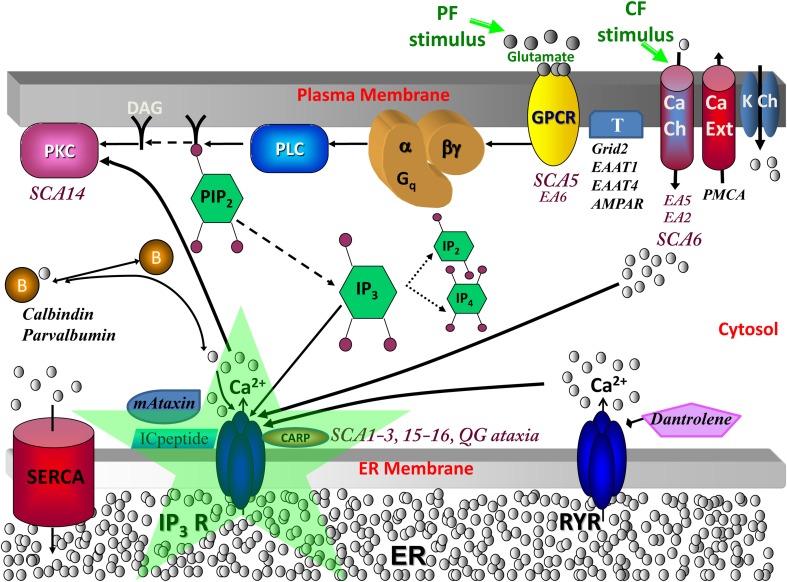Figure 1.
Calcium signaling in cerebellar Purkinje neuron spiny dendrites with various molecules involved in spinocerebellar ataxias. When a parallel fiber (PF) stimulates a distal dendrite of the Purkinje neuron, the neurotransmitter glutamate is released and binds its receptor, metabotropic glutamate receptor (mGluR; from the group C family of G protein-coupled receptors, GPCR), on the plasma membrane of the Purkinje dendrite (Finch and Augustine, 1998; Takechi et al., 1998). This leads to the activation of phospholipase C (PLC), a hydrolyzing enzyme that cleaves PIP2 in the plasma membrane to produce diacylglycerol (DAG) and IP3 (Cohen, 2003). DAG stays in the membrane, where it can activate cytosolic molecules close to the membrane, such as PKC (Nishizuka, 1984). IP3 diffuses away from the reaction site (the plasma membrane) to its receptor on the endoplasmic reticulum (ER) (Berridge et al., 2000). IP3 is also free to diffuse out of the spine head, through the spine neck, into the adjacent dendrite, and along the length of dendrite nearby, part of the dendritic reservoir. At the ER, IP3 binds its receptor, IP3R; the channel opens, releasing calcium from the internal store into the cytosol. This rise in calcium can activate calcium-dependent proteins, including calmodulin, various kinases (including PKC), and other enzymes. The climbing fiber (CF) stimulus depolarizes the entire neuron membrane, opening the voltage-gated calcium channels (Ito et al., 1982). The calcium that flows into the Purkinje neuron spine can also bind IP3R1, along with IP3 from parallel fiber activation of the spine, leading to supralinear calcium release. SCA, spinocerebellar ataxia; EA, episodic ataxia; QG, quadrupedal gait ataxia; K Ch, potassium channels including Kv1.1 (mutated in Episodic Ataxia type 1; Imbrici et al., 2003), Kv3.3 (mutated in SCA13; Waters et al., 2006), Kv4.3 (mutated in SCA1; Duarri et al., 2012 and SCA22 Lee et al., 2012), BK and SK, which are respectively, the large (big) conductance calcium-activated voltage-gated potassium channel which is the potassium channel involved in Purkinje membrane repolarization, and the small conductance calcium-activated voltage-independent potassium channel; DAG, diacylglycerol, which is a product of PLC hydrolysis that along with calcium co-activates PKC; PIP2, Phosphatidylinositol 4,5-bisphosphate, a plasma membrane phospholipid of the inner leaflet that gives rise to DAG and IP3 when hydrolyzed; PLC, phospholipase C, an enzyme that hydrolyzes PIP2 when activated by G-βγ from mGluR; mGluR or Grm1, metabotropic glutamate receptor type 1 (Guergueltcheva et al., 2012); T, other glutamate transporters and receptors including Grid2, Excitatory amino-acid transporter type 1 (EAAT1; mutated in Episodic Ataxia type 6, de Vries et al., 2009), Excitatory amino-acid transporter type 4 (EAAT4; Spectrin β, an anchor for EAAT4 and Grm1 is mutated in SCA5, Ikeda et al., 2006), and AMPAR; B, calcium-binding proteins or buffers including calbindin and parvalbumin (Supplemental Material, S1 Calcium buffers in SCA and Supplemental Figure S2); mAtaxin, mutant ataxin proteins including Ataxin-1 through Ataxin-7; ICpeptide, peptides that resemble the tip of IP3R1 and thereby competitively bind mAtaxin; SERCA, sarcoendoplasmic reticulum calcium ATPase, a transporter for calcium entry from the cytosol to the smooth endoplasmic reticulum (ER); CARP, Carbonic anhydrase-related protein (particularly CARP VIII), an IP3R1 antagonist (Türkmen et al., 2009) (Supplemental Material, S4 IP3R1 suppression by CARP); RYR, ryanodine receptor, a transporter of calcium from the ER to the cytosol in dendrites (but not present in spines) in response to binding of specific ligands such as ryanodine; Dantrolene, a drug that inhibits RYR (Supplemental Material, S2 Calcium-induced calcium release crosstalk); PMCA, Plasma membrane calcium ATP-ase transports calcium out of the cell; Ca Ch, calcium channels including store-operate channels (SOC) for store-operated calcium entry and Cav2.1, which is the main P-type calcium channel in PCs with nonsense/missense mutations causing episodic ataxia type 2, expansion of CAG repeats causing SCA6, and mutations in CavB4 an accessory subunit for Cav2.1 causing EA5 (Escayg et al., 2000); IP3R, inositol trisphosphate receptor (mutated in SCA15/16 and altered sensitivity in SCA1-3, antagonized in QG ataxia), intracellular calcium release channel on the endoplasmic reticulum gated by IP3; PKC, protein kinase C (mutated in SCA14) expressed in Purkinje neurons helps control expression of surface molecules including AMPAR. Adapted from Hernjak et al. (2005).

